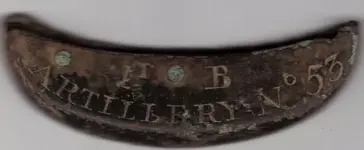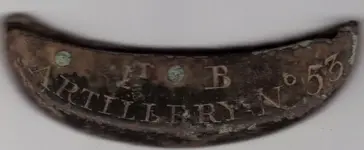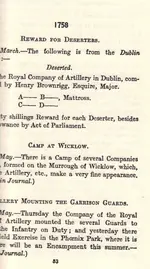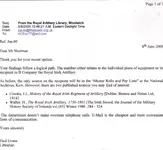hogge
Silver Member
- Joined
- Mar 13, 2008
- Messages
- 3,817
- Reaction score
- 1,513
- Golden Thread
- 5
- Location
- Pittsfield Ma.
- 🥇 Banner finds
- 5
- Detector(s) used
- Teknetics T-2SE--Whites Prism IV
- Primary Interest:
- All Treasure Hunting
First of all, I would like to start off by apologizing for the inaccuracies contained in the April 2009 "Best Finds" Issue of W&E Treasures Magazine. With only a 2 week time frame, and research incomplete, The British Royal Artillery, Cartridge Box Sling, Belt Tip was NOT identified correctly. It IS, IN FACT, a Royal Irish Regiment of Artillery, Cartridge Box Sling Belt Tip! Let me explain................In a conversation I had with Rafeal Ellidge, an appraiser at The Antiques Roadshow, I learned that all the surviving cartridge boxes from the British Royal Artillery, are of high polished brass. They also contain the "ROYAL", or abbreviated, "ROYL" engraving. This got me thinking  . Mine is brass, but painted black, with white inlay letters and numbers. The first letter, which we all thought was a "1", is actually an "I". I was skeptical of this from the start. So I started digging. Here's what I found. In 1687 a Royal Warrent was issued for the establishment of an Office of Ordnance and Train of Artillery in Ireland. Only 40 men were in this Train of Artillery. On April 1, 1756, this Train of Artillery was expanded to a company until 1758 when it was expanded to contain 4 companies. Each company was given a designation of "A", "B", "C", and "D". Equipment for these companies was actually made, by the Irish Board of Ordnance in Dublin Castle. Ireland, even though being under British rule, had it's own Board of Ordnance. Irish arms and accroutments, being modeled after British equipment, often differed greatly on their engravings. Commonly, arms,(and accroutments), within the Irish Establishment were engraved with the Regimental number/ Company letter/ rack or ID number. Whereas British equipment lacked the company letter,(or number), and were only known as Capt. Carter's Co.....etc. Before becoming a "Royal" Regiment, The Royal Irish Regiment of Artillery was known as "The Irish Train of Artillery" and even thereafter. After my 10th E-mail to, The Royal Artillery Museum, the markings on the tip, wich were such a mystery, came to life! "I -T" Artillery, became "IRISH-TRAIN of ARTILLERY" COMPANY"B" rack or ID # 53!!!!!!!!!! BINGO. After a call to make sure, it was confirmed. This is why the markings were such a mystery to them and me. We were just looking in the wrong place. On April 12, 1777, 70 volunteer Mattrosses, from the Royal Irish Regiment of Artillery, were enroute, to Quebec, on board The Royal George. These men were picked from each of the 4 companies. These men were in the company of 1st Lt. James Hadden, later, to be in the command of, Capt. Thomas Jones. Lt. Hadden's Journal, is the most detailed account of Gen Burgoynes Army known to exist. Later accounts, at the Battle of Freeman's Farm, show Capt. Jones and 19 of 23 men under his command, either killed or wounded here. Lt. Hadden and 4 others escaped. 3- 6 pounder guns were captured and recaptured a total of 5 times during the battle. This belt tip belonged to one of the 70 mattrossess, from the Royal Irish Artillery, that fought in the Saratoga Campaign with Gen Burgoynes Army. At NO other time, durring the Revolutionary War, were troops of the Royal Irish Artillery in my area, accept for the Saratoga Campaign, and surrender of the "Convention Army".3200 of these men were housed in our town square,(Pittsfield Ma.) before their march to Boston. This is the site of, which is now, Patrick's Pub and Park Square.( There is a plaque that is there attesting to this event) The relic was found approx. 6-7 miles from this site. My research now takes me to contacting Dublin Castle and it's museum, to see if any cartridge boxes either exist or have survived. 4 Royal Artillery boxes are known. 3 in museums and a 4th in private hands. Being as though, The Royal Irish Regiment of Artillery, was only in existance from 1756-1801,(45 yrs.) I highly doubt it. In 1801 it was absorbed into The British Royal Artillery. There are VERY few relics known from this military unit. Mostly buttons, (and the cross belt plate on the banner). I'm SSOOOO glad I never gave up on the markings of this relic! This research took 10 months and is still unfinished, but I'm getting closer to maybe even finding out who it was issued to. It seems the Irish kept better records of service than the British.(oops did I say that?
. Mine is brass, but painted black, with white inlay letters and numbers. The first letter, which we all thought was a "1", is actually an "I". I was skeptical of this from the start. So I started digging. Here's what I found. In 1687 a Royal Warrent was issued for the establishment of an Office of Ordnance and Train of Artillery in Ireland. Only 40 men were in this Train of Artillery. On April 1, 1756, this Train of Artillery was expanded to a company until 1758 when it was expanded to contain 4 companies. Each company was given a designation of "A", "B", "C", and "D". Equipment for these companies was actually made, by the Irish Board of Ordnance in Dublin Castle. Ireland, even though being under British rule, had it's own Board of Ordnance. Irish arms and accroutments, being modeled after British equipment, often differed greatly on their engravings. Commonly, arms,(and accroutments), within the Irish Establishment were engraved with the Regimental number/ Company letter/ rack or ID number. Whereas British equipment lacked the company letter,(or number), and were only known as Capt. Carter's Co.....etc. Before becoming a "Royal" Regiment, The Royal Irish Regiment of Artillery was known as "The Irish Train of Artillery" and even thereafter. After my 10th E-mail to, The Royal Artillery Museum, the markings on the tip, wich were such a mystery, came to life! "I -T" Artillery, became "IRISH-TRAIN of ARTILLERY" COMPANY"B" rack or ID # 53!!!!!!!!!! BINGO. After a call to make sure, it was confirmed. This is why the markings were such a mystery to them and me. We were just looking in the wrong place. On April 12, 1777, 70 volunteer Mattrosses, from the Royal Irish Regiment of Artillery, were enroute, to Quebec, on board The Royal George. These men were picked from each of the 4 companies. These men were in the company of 1st Lt. James Hadden, later, to be in the command of, Capt. Thomas Jones. Lt. Hadden's Journal, is the most detailed account of Gen Burgoynes Army known to exist. Later accounts, at the Battle of Freeman's Farm, show Capt. Jones and 19 of 23 men under his command, either killed or wounded here. Lt. Hadden and 4 others escaped. 3- 6 pounder guns were captured and recaptured a total of 5 times during the battle. This belt tip belonged to one of the 70 mattrossess, from the Royal Irish Artillery, that fought in the Saratoga Campaign with Gen Burgoynes Army. At NO other time, durring the Revolutionary War, were troops of the Royal Irish Artillery in my area, accept for the Saratoga Campaign, and surrender of the "Convention Army".3200 of these men were housed in our town square,(Pittsfield Ma.) before their march to Boston. This is the site of, which is now, Patrick's Pub and Park Square.( There is a plaque that is there attesting to this event) The relic was found approx. 6-7 miles from this site. My research now takes me to contacting Dublin Castle and it's museum, to see if any cartridge boxes either exist or have survived. 4 Royal Artillery boxes are known. 3 in museums and a 4th in private hands. Being as though, The Royal Irish Regiment of Artillery, was only in existance from 1756-1801,(45 yrs.) I highly doubt it. In 1801 it was absorbed into The British Royal Artillery. There are VERY few relics known from this military unit. Mostly buttons, (and the cross belt plate on the banner). I'm SSOOOO glad I never gave up on the markings of this relic! This research took 10 months and is still unfinished, but I'm getting closer to maybe even finding out who it was issued to. It seems the Irish kept better records of service than the British.(oops did I say that?  ) I'm now, 100%, positive of the markings. I left alot of info out, but will include it in the paper I'm writing about this relic. Hopefully to be published. Once again, I apologize for the inaccuracies. "The Hogge" (I think this "find" just got ALOT better!
) I'm now, 100%, positive of the markings. I left alot of info out, but will include it in the paper I'm writing about this relic. Hopefully to be published. Once again, I apologize for the inaccuracies. "The Hogge" (I think this "find" just got ALOT better!  ) My sources of research included, National Archives UK, Royal Artillery Museum- Woolwich England, History of The Royal Irish Regiment of Artillery by, Major J.J. Crooks, The Artillery Never Gained More Honour- The British Artillery in the 1776 Valcour Island and 1777 Saratoga Campaigns by Douglas R. Cubbison, Silvio Conte' National Archives, Rafeal Ellidge- The Antiques Roadshow, History of 62nd Regiment of Foot, Lt. Hadden's Journal, and countless other internet websites
) My sources of research included, National Archives UK, Royal Artillery Museum- Woolwich England, History of The Royal Irish Regiment of Artillery by, Major J.J. Crooks, The Artillery Never Gained More Honour- The British Artillery in the 1776 Valcour Island and 1777 Saratoga Campaigns by Douglas R. Cubbison, Silvio Conte' National Archives, Rafeal Ellidge- The Antiques Roadshow, History of 62nd Regiment of Foot, Lt. Hadden's Journal, and countless other internet websites
 ) I'm now, 100%, positive of the markings. I left alot of info out, but will include it in the paper I'm writing about this relic. Hopefully to be published. Once again, I apologize for the inaccuracies. "The Hogge" (I think this "find" just got ALOT better!
) I'm now, 100%, positive of the markings. I left alot of info out, but will include it in the paper I'm writing about this relic. Hopefully to be published. Once again, I apologize for the inaccuracies. "The Hogge" (I think this "find" just got ALOT better! Attachments
Upvote
0












